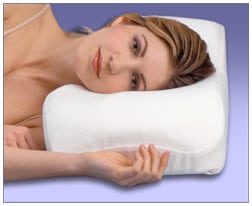Pillow talk!
You spend a lot of time with your pillow, but how much thought goes into choosing one?
We all do it – we all need it – but not all of us get it in good enough quality. I’m talking about sleep.
One reason may be your pillow. Most of us have heard the mattress mantra urging us to replace every eight’ years but how often should we change our pillow – and what sort of pillow would give us the best night’s sleep?
Read our blog for some simple, practical tips on choosing the right pillow for you.
Pillow perfection
There are so many different types of pillow – the choice can be a bit bewildering. It’s a very individual purchase; one person’s dream pillow is another’s nightmare.
Comfort is so subjective. One person may find the material filling of a pillow ideal for them – that could be latex, which tends to sort of bounce back immediately, whereas others might like a soft enveloping type of pillow like a feather or a down pillow. So it’s very much personal preference.
What you have to consider is the type of support that you like. So do you like a shallow or a deeper pillow, and do you prefer a softer pillow to a firmer one? These are some of the things to consider.
Most Physiotherapists believe that there is no one perfect pillow for everyone. There’s only the perfect one for you as an individual.
Pillow position
 The conventional wisdom says a good pillow should keep your head in ‘neutral alignment’ – meaning it’s sitting squarely on your shoulders, not bending too far back or forward. We’re told we should use our pillow to produce the same position for our shoulders and spine as if we were standing upright with the correct posture.
The conventional wisdom says a good pillow should keep your head in ‘neutral alignment’ – meaning it’s sitting squarely on your shoulders, not bending too far back or forward. We’re told we should use our pillow to produce the same position for our shoulders and spine as if we were standing upright with the correct posture.
Neck pain or stiffness and even persistent headaches could be the result of poor pillow support while sleeping.
So, the right pillow can be important. Much depends on the position you sleep in. There are three main types of sleeping position:
- On your back – you will need thinner pillows so your head is not thrown too far forward. Also, look to cradle your neck with an extra bit of height in the bottom third of your pillow, nearest your neck.
- On your front – tummy sleepers need a very thin, almost flat, soft pillow. We don’t on the whole recommend sleeping on your tummy as it requires you to sleep for long periods with your head turned in an extreme position. Tummy sleepers often have a favourite side to turn their head and so often become stiff to the opposite direction.
- On your side – you will need a fluffier, thicker pillow to fill in the space between your head and shoulders. This gap varies according to your build so try to match the thickness to the space between your ear and top of your shoulder.
- If you toss and turn and sleep in all three of these positions then choose a medium-thickness pillow which can be either a high-fill down pillow or a medium synthetic one.
Types of pillow
Down or feather pillows are usually recommended by sleep experts as one of the best type for a good night’s rest, although pillows can be filled with almost anything. The most commonly used ones are down-feather combinations, foam, or a polyester fibre fill. All have their pros and cons.
- Feather pillows. Soft and flexible but it’s worth checking on the contents. Chicken feathers, can straighten with time and quills could then poke through to the outside of the pillow and disturb your sleep. These pillows may sink during the night reducing the support they give.
- Down pillows. Extra soft but firm enough to give support where needed. Down pillows don’t have any sharp quills because they are made from the delicate fluffy feathers found beneath the tougher exterior ones. The softness and cost, and down pillows are often pricey, will go up in proportion to the amount of down inside. One of the positive things about down pillows is that you can move the stuffing around so that you have the most support where you need it.
Many down pillows are washable.
- Foam or latex. These pillows tend to be firm with a definite bounce to them. They hold their shape well and are considered hypo-allergenic – although people with breathing problems like asthma may still want to use a special barrier cover. Specially moulded ‘orthopaedic’ pillows to support the neck are often made of this material and you can use them with a softer pillow on top if needed.
 Memory foam is polyurethane with added chemicals. It moulds its shape to you but bounces back once you remove your head. However, it can be quite smelly. These pillows can also leave you with a hot head, so if you like the feeling of cool bedding it may not be for you. Plus, if you sleep in a very cool room, some will get hard and feel uncomfortable.
Memory foam is polyurethane with added chemicals. It moulds its shape to you but bounces back once you remove your head. However, it can be quite smelly. These pillows can also leave you with a hot head, so if you like the feeling of cool bedding it may not be for you. Plus, if you sleep in a very cool room, some will get hard and feel uncomfortable.- Polyester filled. These are the most popular pillows and vary from soft to very firm. They’re usually quite cheap and are often machine washable. However, they can offer poor neck support and may be vulnerable to dust mites.
Looking after your pillow

dust mite
According to experts around 10% of the weight of an old, unwashed pillow could be made up of skin scales, mould, fungi and dead and living dust mites!
To keep a pillow in its prime condition it should be replaced every 2 to 3 years and washed every 3 months.
Pillows that have lost their height, are lumpy, misshapen or discoloured are definitely past their ‘best before’ date!
Pillow price
Don’t let price be your guide. You may be able to pick up two pillows for under a tenner or you could spend hundreds. Just because a pillow costs more does not automatically make it a better pillow or the right pillow for you.
As pillows are such a personal thing it could be a cheap one will suit you best, although it may not stay like new or retain its level of support for as long as a more expensive one and may need to be replaced sooner.
And do try before you buy – especially if the store has a demonstration pillow already out of its packaging. You can’t really get a great idea of the pillow when it’s still in its plastic bag.
So if you’re going to a bed store, if they have pillows on display in their packaging ask the assistants whether they have one of those pillows out of its packaging so you can give it a try or lie on a bed with it.
And if that all seems a bit too much of a fuss for you, remember how long you spend in bed with your head on your pillow and how important it is to get a good night’s sleep!
If you are suffering with neck pain or headaches and would like to make an appointment with one of our Physiotherapists please call 020 8876 5690, click here to email us or pop in. Our Physios are always happy to chat things over before booking.



